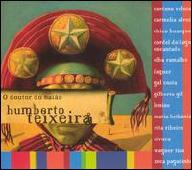Leaving Ceará to settle in Rio, two years after his arrival in this city, was one of the winners of the Carnival music contest promoted by humor magazine "O Malho" in 1934. He had the honor of seeing classified in the fifth place his music Meu pedacinho side by side with compositions of already established composers, such as Ary Barroso, Índio, Cândido das Neves, José Maria de Abreu, Capiba and Ari Kerner.
At that time he was already publishing his varied compositions through Guitarra de Prata, and this new one wouldn't be enough for him to make it to the recording studios. He continued his studies, becoming a lawyer in 1943, dividing his time between his private practice and music. His first hit would be Sinfonia do Café (with conductor Lírio Panicali), 1944, soundtrack especially wrote for the show #Muiraquitã, which would be produced in the Teatro Municipal do Rio de Janeiro. Sung for Continental by singer Déo and Coro dos Apiacás, through Continental, Sinfonia do Café would soon be followed by Natalina(with E. Guimarães), recorded by Quatro Ases e um Curinga. 1945 would be a very important year for Humberto Teixeira. He would know his most important partner, who surely gave his career a fundamental push: Luís Gonzaga, "O Rei do Baião". Luís, northeastern sanfoneiro already acclaimed by his regional work, needed a lyricist for his compositions. Deciding to opt for the baião style as the vehicle for that new identity for northwestern music that they wanted to forge, they started their extremely successful partnership. In 1946, Ciro Monteiro recorded Deus me perdoe (H. Teixeira and Lauro Maia) through Victor, and Orlando Silva Só uma louca não vê (H. Teixeira and Lauro Maia) through Odeon. The first composition with Luís Gonzaga, Baião, would soon follow in this same year. In this rendition by the Quatro Ases e um Curinga the folkloric northeastern instruments made their debut at the South: acordeon, triângulo and zabumba. The exotic flavor took Brazil as a fever, and their success assured. Until the 50's, they would write a hit after another: Asa Branca, No meu pé de serra, Mangaratiba, Juazeiro, Paraíba, Qui nem jiló, Baião de dois, Assum preto, Lorota boa, Xanduzinha and many, many others. The craze would make southerners like Hervê Cordovil and Waldir Azevedo adhere to northwestern rhythms. Baião would travel outside the frontiers of Brazil and become known worldwide through The Drifters ("Save The Last Dance For Me"), Elvis Presley ("Hound Dog"), The Beatles" ("She Loves You") and Burt Bacharach ("Do You Know The Way To San Jose"). In 1950, Humberto Teixeira decided to dispute elections for Congress representation. Elected with great margin in his state Ceará, due to the enormous popularity of his work with Luís Gonzaga, dissolved the partnership with him. Beginning a new life, where music would give room to legal battles in favor of authoral rights, Humberto succeeded in making Congress to approve, in 1958, the Humberto Teixeira bill, which created missions that traveled abroad to promote Brazilian music. Leading all "caravanas" (as these missions became known) until 1964, Humberto became internationally renowned as composer, having his songs recorded in several idioms. In 1971, was elected director for UBC. His compositions enjoy immortality in the popular soul, despite ups and downs because of fashionable trends. In 1972, Tropicália would drink on the waters of the northeastern primitive rhythms, introducing in it's repertoire a wealth of themes written by Gonzaga/Teixeira. Their great heritage is composed of 400 compositions, and their deed of having put Northeast in the musical map must be stressed. In a reference to the lyrics of the first and one of the most popular songs of the duo, Baião, it can be said that Luís Gonzaga and Humberto Teixeira came to teach the world how to dance the baião. ~ Alvaro Neder, Rovi


















